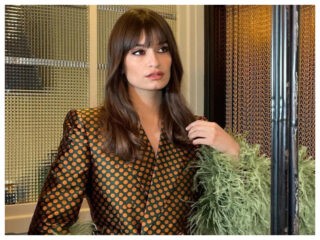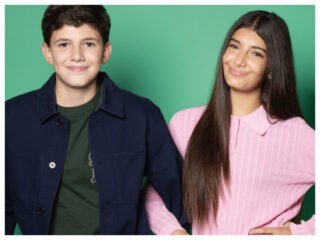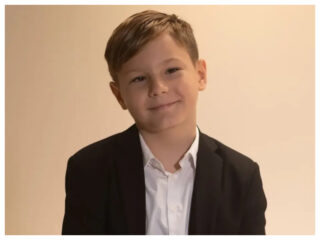Eurovision is typically a once-in-a-lifetime experience. But some artists, keen to experience the magic yet again or revive their faltering careers, give it another go. Dana International, for instance, won the entire contest in 1998 and took on the adventure again in 2011 (albeit with dramatically different results).
Still other contestants return representing an entirely different country. The majority of these instances occurred in the early decades of the contest, when broadcasters, particularly those from smaller countries, invited a performer of their own choosing. It makes sense. Many of these countries, like Monaco and Luxembourg, have small populations, which makes it difficult to consistently supply local talent. So instead they picked from abroad, often choosing artists who already had a large following in their country. Fair play!
Most of those acts came from culturally similar nations that spoke the same language. So, in one storied example, French-speaking Anne-Marie David sang for Luxembourg and won it all. She returned six years later for France and placed third. Still other artists decided to compete for another country after failing to win a national selection at home (see, for instance, Estonia’s Vanilla Ninja who sang for Switzerland).
Whatever the case behind the cross-cultural exchange, this much is clear: the glitz and the glamour of Eurovision is more than enough to pull artists across borders and back into the contest..
So, the Eurovision 2018 season ramps up, we celebrate those artists who have built bridges across countries and time by representing more than one country at Eurovision.
Jean Philippe: France and Switzerland
Countries represented:
• France: 1959 (3rd place)
• Switzerland: 1962 (10th place)
Jean Philippe was the first artist ever to represent two different countries on the Eurovision stage. The chansonnier flew the flag for his native France at the Eurovision Song Contest 1959, which was held in Cannes, and came third with the song “Oui, oui, oui, oui“. Three years later, he once again said yes, yes, yes, yes — this time when Luxembourg invited him to represent them with the song “Le retour“. He didn’t repeat his previous success. However, Jean Philippe did win new fans and remained a popular chanson singer in Francophone countries in the 1960s.
Siw Malmkvist: Sweden and West Germany
Countries represented:
• Sweden: 1960 (10th place)
• West Germany: 1969 (9th place)
Siw Malmkvist represented Sweden at the Eurovision Song Contest 1960 with “Alla andra får varann“, and returned nine years later for West Germany with “Primaballerina“. A native of Sweden, she enjoyed chart success throughout Scandinavia and West Germany. A polyglot of the first order, she recorded songs in Swedish, Danish, Norwegian, Finnish, German, Dutch, English, French, Italian and Spanish. Das ist how you slay!
Building on her Eurovision momentum, Malkmvist had become a huge star in West Germany by 1964, when she had a number one hit with “Liebeskummer lohnt sich nicht”. The same year, she became the first Swedish artist to have a song chart on the US Billboard Hot 100 with “Sole Sole Sole” — a duet with Umberto Marcato. Five years later West Germany called and the S-I-W answered.
Tereza Kesovija: Monaco and Yugoslavia
Countries represented:
• Monaco: 1966 (17th place)
• Yugoslavia: 1972 (9th place)
Tereza Kesovija‘s distinct vocals garnered pan-European recognition. She’s still regarded as one of the biggest divas of all time in the Balkans, and enjoyed considerable success in Continental Europe in the 1960s and the 1970s.
In 1965, Kesovija moved to France in order to pursue an international career and became popular thanks to her recording of the theme song to the film Doctor Zhivago. Grace Kelly, who had married into the royal family and was now the Princess of Monaco, personally chose Tereza to represent Monaco at the Eurovision Song Contest 1966. In spite of the royal intervention, Kesovija’s entry “Bien plus fort” finished 17th with nul points.
Six years later, Kesovija — who was the favourite singer of Yugoslavia’s president Tito — represented her native country with the song “Muzika i ti“. This time she achieved a much better result, placing ninth.
Romuald Figuier: Monaco and Luxembourg
Countries represented:
• Monaco: 1964 (3rd place), 1974 (4th place)
• Luxembourg: 1969 (11th place)
Romuald Figuier took part in Eurovision a total of three times, but never represented his native France. He competed twice for Monaco and once for Luxembourg.
His first attempt — representing Monaco in 1964 with the song “Où sont-elles passées” — resulted in a third-place finish. In 1974 he pretty much held the standard with “Celui qui reste et celui qui s’en va” and placed fourth. “Catherine” — his entry for Luxembourg — only reached 11th place.
Michèle Torr: Monaco and Luxembourg
Countries represented:
• Luxembourg: 1966 (10th place)
• Monaco: 1977 (4th place)
Just like Romuald Figuier, Michèle Torr is French and at Eurovision she competed for Monaco and Luxembourg. She too had more success with Monaco.
Singing for Luxembourg in 1966, when the contest was held in Luxembourg City, she came tenth with the song “Ce soir je t’attendais“. Disappointing. But she returned to the festival in 1977, this time representing Monaco, and achieved a much better position — fourth place — with “Une petite française“.
Talk about longevity: Torr remains well-known in Francophone countries. Her last album Tout l’amour du monde was released in 2016. She’s tried many times to represent France at Eurovision, but the French broadcaster hasn’t bit.
Anne-Marie David: Luxembourg and France
Countries represented:
• Luxembourg: 1973 (1st place)
• France: 1979 (3rd place)
The French singer has quite an impressive record. She participated twice, achieving one victory and one third place. Anne-Marie first appeared on the Eurovision stage in 1973 representing Luxembourg with “Tu te reconnaîtras“, and won by just four more points over runner-up Mocedades with “Eres tú” and six more than the third-placed Cliff Richard with “Power to All Our Friends“.
Anne-Marie was the first Eurovision winner to attempt to win the contest again, when she returned to the festival in 1979. She represented France with the song “Je suis l’enfant soleil“, and despite being one of the favourites for the win, she finished third behind Israel and Spain.
She’s enjoyed a rather successful career both in France and abroad, especially in Norway. In 2013, she submitted a song to the French national selection, but the broadcaster ultimately went for Amandine Bourgeois instead. But she had perhaps an even bigger honour, performing “Tu te reconnaîtras” at the Eurovision 60th anniversary concert in London.
Hearts of Soul / Dream Express: The Netherlands and Belgium
Countries represented:
• The Netherlands: 1970 (7th place)
• Belgium: 1977 (7th place)
Hearts of Soul started off as a girl group founded by Dutch sisters Bianca, Stella and Patricia Maessen. The trio represented The Netherlands at the Eurovision Song Contest 1970 with the song “Waterman“, and finished seventh out of twelve contestants.
But when Bianca married Belgian musician Luc Smets, the entire group moved to Belgium, where they formed Dream Express with Luc. The quartet went on to represent Belgium at the 1977 contest with the entry “A Million in One, Two, Three” and placed seventh in the field of eighteen.
The group achieved considerable chart success in The Netherlands and Belgium, most notably with their singles “It’s Great Fun” and “Dream Express”. They officially disbanded in 1996, following Patricia’s death (from a stroke).
In 1982, Stella represented Belgium as a solo artist with “Si tu aimes ma musique” and finished the fourth. Patricia also returned to Eurovision twice more as a backing singer, for Sandra Kim (Belgium 1986) and Plastic Bertrand (Luxembourg 1987).
Ireen Sheer: Luxembourg and Germany
Countries represented:
• Luxembourg: 1974 (4th place)
• Germany: 1978 (6th place)
Ireen Sheer was born Ireen Woldridge in Essex, the United Kingdom, but built her career in continental Europe, mostly in Germany, where she had several hits. In 1974, she was invited to represent Luxembourg at the Eurovision Song Contest 1974; she performed “Bye Bye, I Love You” and placed the fourth. Four years later, Sheer competed for Germany with the entry “Feuer” and placed sixth.
Sheer continues to record and release music in Germany. In 2002, she competed in the German national selection, but failed to win.
Anna Vissi: Greece and Cyprus
Countries represented:
• Greece: 1980 (13th place), 2006 (9th place)
• Cyprus: 1982 (5th place)
The Cyprus-born singer competed three times at Eurovision, twice for Greece and once for Cyprus. Anna Vissi had already been well-known in Greece when she represented the country at Eurovision in 1980 with the entry “Autostop“, so her final result — 13th place — was rather disappointing. Vissi returned to the contest in 1982, this time representing Cyprus; her entry “Mono I Agapi” finished in fifth, giving Cyprus its best result ever.
More than twenty years later, Vissi made another attempt to win Eurovision, representing Greece at the 2006 contest that was held in Greece. In spite of the singer’s emotional performance of “Everything“, she only placed ninth.
Although her Eurovision results were so-so, Vissi’s career certainly hasn’t been. In Greece she is one of the biggest pop stars and one of the best-selling music artists of all-time.
Elisabeth Andreassen: Sweden and Norway
Countries represented:
• Sweden: 1982 (8th place)
• Norway: 1985 (1st place), 1994 (6th place), 1996 (2nd place)
Elisabeth Andreassen has an impressive record at the Eurovision Song Contest — she took part four times and placed within the top ten on all four occasions. Born in Sweden to parents from Norway, she represented both countries. In 1982, as a part of the female duo Chips, Andreassen sang “Dag efter dag and achieved eighth place for Sweden.
Three years later, Andreassen formed the duo Bobbysocks with Hanne Krogh. The combination turned out to be a triumphant one, as their entry “La det swinge” gave Norway its first Eurovision victory. Andreassen returned to the contest twice more, representing Norway both times — in 1994 with “Duett“, a duet with Jan Werner Danielsen, and in 1996 with “I evighet“. She placed sixth and second, respectively.
Doris Dragovic: Yugoslavia and Croatia
Countries represented:
• Yugoslavia: 1986 (11th place)
• Croatia: 1999 (4th place)
Doris Dragovic participated in Eurovision twice, both times representing her own country, which with the course of history, became two countries. Dragovic first represented the Socialist Federative Republic of Yugoslavia at the 1986 contest with the song “Zeljo moja” and ended up in 11th. When the singer returned to the contest in 1999, Yugoslavia had already fallen apart and Croatia became an independent country.
At the 1999 contest, Dragovic performed “Marija Magdalena” and placed fourth, tying Maja Blagdan‘s result as the best-placed Croatian entry ever. Her performance caused a small controversy as pre-recorded backing vocals were used instead of live backing singers.
Doris Dragovic enjoyed huge popularity in the 1990s and still remains well-known in the countries of former Yugoslavia.
Feminnem: Bosnia and Herzegovina and Croatia
Countries represented:
• Bosnia and Herzegovina: 2005 (14th place)
• Croatia: 2010 (13th place in the semifinal)
Feminnem were formed by Ivana Maric, Neda Parmac and Pamela Ramnjak, who had all taken part in the Croatian edition of Pop Idol. As both Maric and Ramljak were born in the Croatian part of Bosnia and Herzegovina, the group decided to take part in the national selection in that country — and won. At the 2005 contest in Kyiv, Feminnem performed “Call Me” and finished 14th in the final.
The group then tried to win the Croatian national selection in 2007 and 2009, before managing to do so in 2010. However, their entry “Lako je sve” failed to qualify for the grand final in Oslo.
Zeljko Joksimovic: Serbia and Montenegro and Serbia
Countries represented:
• Serbia and Montenegro: 2004 (2nd place)
• Serbia: 2012 (3rd place)
Like Doris Dragovic, Zeljko Joksimovic also represented his native country both times. When Joksimovic first took part in 2004, that country was called Serbia and Montenegro. When he came back in 2012, the country had already split in two.
Joksimovic gave Serbia and Montenegro an impressive Eurovision debut in 2004, as his entry “Lane moje” placed second. In 2012, the singer represented Serbia with “Nije ljubav stvar” and achieved another impressive result with third place. Joksimovic also composed the songs for Bosnia and Herzegovina 2006, Serbia 2008 and Montenegro 2015.
What do you think? Could you represent any country other than your own? How would you decide?! Tell us in the comments section below!











Another forgotten performer is Bojan Jovovi? who was part of both No Name (Serbia and Montenegro 2005) and Highway (Montenegro 2016). It’s a little bit different with him, Doris and Zeljko as they represented their own country on both occasions and it was under a different name of that country due to political reasons. The other people represented two nations with no overlapping territories, at least. It’s a shame that Michele Torr didn’t get a chance to represent France. It would be cool to have someone performing under 3 different flags. I’m surprised there’s not a single artist performing for… Read more »
The closest would have been Nathan Trent had he been selected internally by Austria for 2018 instead and if by some miracle won Unser Song 2017 had he not withdraw his participation.
Jean Philippe didn’t represent Luxembourg as you mention in the text.
You forgot Elpida & Eirikur Hauksson…
Elpida represented Greece in 1979 and returned for Cyprus in 1986. You really should do your research before posting such articles.
Such situations are not a surprise, especially after Yugoslavia was split in the early 90s. The most well known entries related to the the fall of Yugoslavia are Doris Dragovic (the 1999 song was amaizing), Feminem and Zeljko. Anna Vissi didn’t start quite well at Eurovision. But her 1982 song was so good. As for her 2006 participation, I think it was the best choice for a home country. She’s a great singer and performer and it would be the best way to showcase the talent of this Greece. Although I wasn’t a fan of “Everything” she nailed it in… Read more »
Ireen sheer also represented Luxembourg in 1985 as a part of a group singing ” Children, Kinder, Enfaints”.
Sahlene sang lead for Estonia in 2002 and provided backing vocals for Sweden in 1999 and Australia in 2016 🙂
You have a mistake, the first Eurovision winner who tried to win a second time is Lys Assia
She won in 1956 and I’m pretty sure she reached the 3rd place in 1958
Actually, she reached second place in 1958 (with “Giorgio”). She also took part in 1957 with “L’enfant que j’étais”.
I guess it’s about those artists who came back…..BUT FOR ANOTHER COUNTRY.
Eiríkur Hauksson took part 3 times.
1986 – Iceland – as a member of ICY
1991 – Norway – as a member of Just 4 Fun
2007 – Iceland – solo
A very interesting article, thanks! Far be it from me to correct other people ( 🙂 ) – but I must point out a small error in fact, –
“Anne-Marie was the first Eurovision winner to attempt to win the contest again, when she returned to the festival in 1979.”
Lys Assia, the very first winner, returned to defend her title in 1957, and then again in 1958. Corry Brokken, winner in 1957, returned to defend her title in 1958 too.
She meant probably first winner to try to win for another nation maybe?
Ireen Sheer has another entry to add. It was in 1985 representing Luxembourg again, together with Margo (Dutch), Franck Olivier (luxembourgian) , Diane Solomon (American), Malcolm Roberts (British) and Chris Roberts (German)
The song was “Children, Kinder, Enfants”
They placed 13th. The composer was Ralph Siegel
Yaasss Doris Dragovic, both her entries are flawless. Marija Magdalena is THE standout Eurovision track of the late 90s. Truly a disco gospel classique, when will your basic faves.
come thru the ICONIC Marija Magdalena